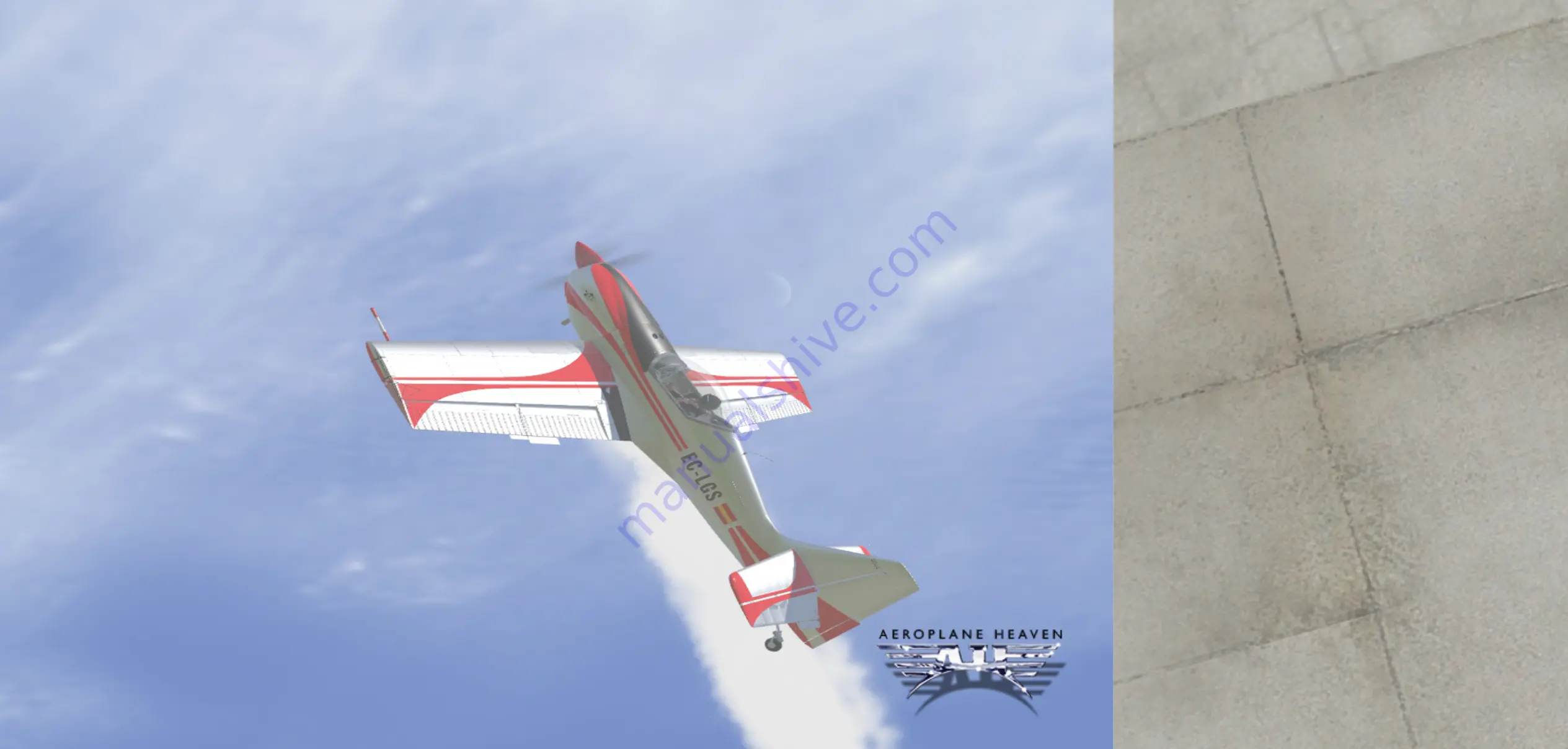
We are going to make the
assumption that you have some hours
time, flying in flight simulators like P3D.
Also, it is not our intention to teach you
how to fly, real or virtual.
Right, having got the disclaimers
out fo the way, let’s have some fun.
We’ll begin by going through the
procedures for a “cold-dark” start. That
is, all switches are off and all knobs,
levers and controls are at their mini-
mums.This is the best way to get
maximum immersion from a simulation
like the Zlin Z50LS.
So, the only switch that should be
ON at this time is the “Remove/Add Pi-
lot” (RIGHT CIRCUIT BREAKER) which
should be clicked to show no pilot and
the canopy should be open.
OK first up, board your pilot.Now,
you’ll need some power. Switch ON
the Battery Master Switch and also the
Alternator switch.Turn on the Avionics
Master Switch (23) to get power to some
of the instruments.(Not all instruments
are electric).
The real Zlin does not have a
parking brake lever as such, it uses the
brake pedals. So use the keystroke to
ensure that your parking brake is set.
Flying the Zlin Z50LS
If you are in the aerobatic version,
select the main fuel tank on the selector.
The control (27) uses left and right click.
Turn on the fuel pump (16) and check
that there is fuel pressure. After 15 sec-
onds or so turn it off again. Set your
Mixture Lever to full rich (forward) and
push the Prop Pitch Control full forward
to MAX RPM.
Switch the Master Ignition ON (18)
Now, turn the Magneto key through
RIGHT, LEFT and settle at BOTH. When
you are set, turn the key once more to
the right to START. The engine should
roar into life and gauges should show
some signs of life. Check the vitals.
Warm up the engine at around
1200 RPM and do a mag-check. You do
this by turning the Magneto switch back,
first to LEFT, then to RIGHT, noting a
drop in RPM of no more than 50 RPM.
This indicates correct operation of the
magneto. Quickly return to BOTH and
throttle back to idle.
Time to tune your radios for NAV
and COMMS, once you have acquired
the correct frequencies.
Now, carefully check your engine
gauge for oil pressure, temperature and
fuel pressure readings and ensure they
are within recommended limits.
You are now ready to go-ready to
taxy.
Taxying in the Zlin is not difficult
but must be done with care. The motor
is extrememly powerful and you do not
need a lot of throttle.
Apply a small amount of power
and release the brakes. Small adjust-
ments using differential braking with the
rudder is the way you steer a Zlin on the
ground. Taxy out to the hold and check
all your gauges.
With all that power under the
hood, you will be airborne in no time.
Froma standing start, a ZlinZ50LS will
get airborne in just 6 seconds!
Your takeoff run, with a normal load will
only be 495ft or 985ft. to clear 50ft!
Start the run with the control stick
back, then, push the stick gently forward
to unstick the tailwheel at 50 km/h. We
are only talking seconds here, as you
get used to the aeroplane this procedure
will flow into one continuous movement
over maybe 3 seconds.
At around 110 km/h, she’ll be
wanting to lift off. Gently pull back on the
stick and lift off.Trim the tail as neces-
sary as you accelerate (quickly!) to 130
km/h.
Once above 130 km/h she’ll climb
fast at up to 2,600 ft per minute! A climb
angle of 45
0
is possible but watch your
airspeed until you have plenty in
reserve.
If you are flying the ferry version
with wing-tanks, you MUST balance the
fuel from each wing-tip to keep a level
flying attitude. Keep checking the sight
glasses on each tank and use the se-
lector regularly to balance the levels.
NEVER exhaust the main tank - this is
your reserve. Use the fuel in the wing-tip
tanks first. If you still have fuel in these
tanks, switch to the fullest tank for land-
ing. If that is the central main tank, then
use that.
Landing is not difficult but allow
plenty of time to adjust your speed - you
have no flaps - and a 3-pointer is
preferable. Stick right back after touch-
down and brake carefully.
We sincerely hope you get as
much pleasure from flying this beautiful
little machine as we did building her.
Copyright Aeroplane Heaven December 2020
PRE-START
PARKING BRAKE
ON (use keystroke-there is no handle)
BATTERY
ON
ALTERNATOR ON
THROTTLE
1/4 INCH CRACKED
PROPELLER
MAXIMUM (FULL FORWARD)
FUEL SELECTOR
MAIN TANK
FUEL PUMP
ON - CHECK FUEL PRESSURE THEN OFF
MIXTURE
FULL
RICH
IGNITION MASTER
ON
MAGNETOS
TO
BOTH
STARTING
MAGNETOS
TO
START
THROTTLE
1000 RPM
CHECK OIL PRESSURE MINIMUM 177 kPa
NAV
LIGHTS
ON
WARM-UP
THROTTLE
1000-1200 RPM (DO NOT EXCEED 2200 RPM)
OIL PRESSURE
MIN - 177 kPa MAX - 686 kPa
OIL TEMPERATURE
MIN - 35
0
C
MAGNETOS
CHECK (2200 RPM) LH-RH-BOTH
MAX DROP 175 RPM DIFFERENCE BETWEEN LH
AND RH MUST NOT EXCEED 50 RPM
CHECKLISTS
You’re virtually there.


























